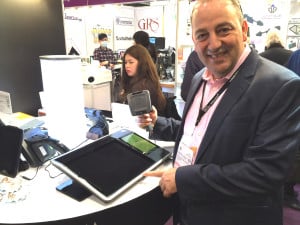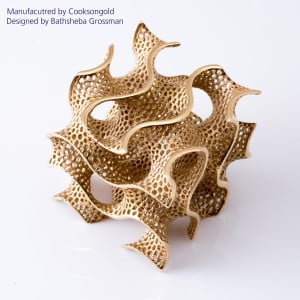
For those who know me, know that I love technology and that I am constantly searching out the latest gadgets. I recently purchased a fabulous little tool which allows me to drag photos and movies off my iPhone and iPad onto a memory stick. The same stick has a USB plug on the reverse side so you can just plug it into your computer and drag the files across when you don’t have a reasonable phone or Wi-Fi connection… this is a life saver! I ended up buying four to give as gifts to some techno buddies.
This article isn’t about current tech gadgets; it’s about what innovations are to come, and how you might be able to innovate in your world.
Two months ago I wrote about the World Diamond Mark Conference and some of the innovations that we saw there.
In particular, the scanner to manage stock (see image) that Chow Tai Fook is using in their 2000 stores, and now available to any jewellery retailer through Myndar (www.myndar.com).
Then there is Cooksongold who have a CAD program that interfaces directly into printing an item of jewellery into gold or Platinum. That’s right, you don’t have to make a wax mould! You can print direct into metal! Check out www.cooksongold-emanufacturing.com.
Are you aware that the both HRD and GIA are using a scanner to grade the colour of diamonds, and in HRD's case, they have been doing so for a number of years already?
I can comfortably predict that a company like Sarine Technologies - if not the GIA themselves - would be close to developing a machine which is able to accurately and consistently grade the clarity of a diamond. This has to be the case as they are grading thousands of stones a day.
After all, we are talking about simply entering stored data from all the millions of certificates that they have on file. These have already been plotted in their data base against the results and, with the sophistication that Sarine has in grading rough diamond; this would be a "fait de complete".
In fact, I don’t know what we are waiting for. Computer analysis would surely remove the issue of inconsistent grading that has, and will continue, to damage both the consumer confidence and the reputation of our diamond industry.
You might well ask, 'what is next to impact on our industry'?
My answer? It’s called "deep thinking".

A 3D printed gold sculpture by Cooksongold
Right now when you buy from Amazon it makes suggestions as to what other products you may wish to buy. The natural progression to this is where analytics programs are looking at your Facebook, LinkedIn, Instagram, Pinterest and Twitter. In fact your overall web searches.
And this is just the beginning.
For now, this software can see what you are following, your interests, the brands you like, the famous people you watch, the food you like and the events you are interested in.
Now let’s go another level deeper.
What about the fact that this "deep thinking" software can actually see the images you look at. Let me explain.
The program doesn't look at an image as a host of colour pixels; it actually understands what it is seeing. It is seeing you on Facebook wearing, for example, a red high neck, mid-thigh dress.
It looks at your shoes, your hair style, and other people in your photo who have been tagged, and scans their profile, so it understands your socio economic status. The analysis identifies brands associated with you and your friends and possible price points.
Is it so farfetched to think that a website could recommend to you a piece of jewellery you or your customer would love, and that falls into the perfect price range? In the future, this information could be available to the retailer!
Your customer walks into your store and you get a message on the screen of their buying history and suggestions of what they would like.
This is not science fiction!!!
During my most recent stay in my favourite Hong Kong hotel I was impressed when a staff member approached me and asked to take my photo. Why? So that other staff members could identify me in future as one of their regular patrons.
I must say I had never thought of doing this in a store, though it begs the question, why don’t we?
Frankly, why not? It’s not an invasion of privacy – providing you ask first.
What if you issued your customers with a rewards card with a built in RFID chip? With a small RFID reader at the entrance, when the regular customer comes into your store, their picture and purchase history would automatically pop up on your screen.
Who doesn't love being remembered and identified by name? It’s personalising service that is making the difference in today’s market.
The wild innovations I have just touched on are already being implemented by some; but many of these innovations are things you and I could do now!
Let me finish with a story I heard at breakfast. A men’s tailor in Sydney was just kicked out of a major shopping centre. Determined to succeed he started to put photos up every day on Instagram. He began following every male fashion model and every bridal site he could worldwide. He became more creative with his suits and just worked off referrals.
Using this tried and tested technique, he sent one of his suits to a top model as a gift to wear and asked that he post some pics of himself on Instagram. In less than two years he has been asked to exhibit in New York at one of the most renowned fashions weeks…
Let’s not complain about how things are bad or different, but ask ourselves how we can use the innovative technology around us today in business.
Trade well.